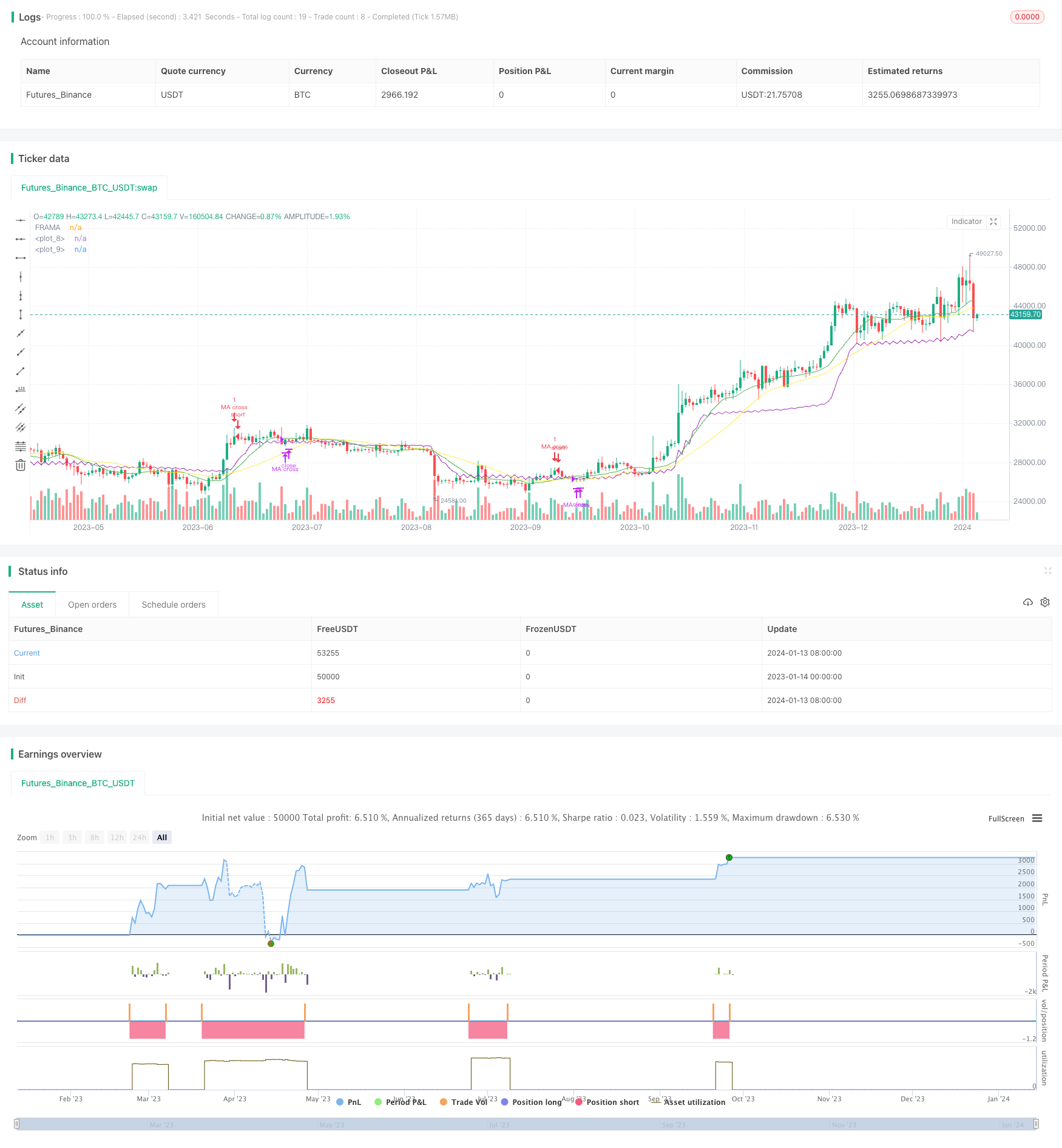
概述
本策略首先计算快速移动平均线ma_fast和慢速移动平均线ma_slow,然后结合FRAMA自适应移动平均线,在ma_fast上穿ma_slow时做多,在ma_slow下穿ma_fast时或FRAMA下穿收盘价时平仓。
策略原理
计算13日简单移动平均线ma_fast和26日简单移动平均线ma_slow。
计算FRAMA自适应移动平均线out。FRAMA的计算公式较复杂,主要思想是根据价格的最高值、最低值和波动性动态调整均线的平滑度α。
在ma_fast上穿ma_slow时做多。这表示短期均线开始上行,并跑赢长期均线,符合趋势的特征。
在ma_slow下穿ma_fast时或FRAMA下穿收盘价时平仓。这表示趋势反转信号。
优势分析
结合双均线系统和自适应均线系统的优点。双均线系统擅长捕捉趋势,自适应均线系统可以更好地滤波噪音。
FRAMA指标可以自动调整参数,避免人工选择参数的主观性。
同时使用两个退出信号,可以及时捕捉趋势反转。
风险分析
双均线交叉存在错位的可能,可能产生间歇性亏损。
自适应移动平均线会增加策略的参数量,可能导致过度优化。
仅考虑价格因素,没有结合交易量做过滤,可能错过机会。
优化方向
可以测试不同周期的均线组合,寻找最佳参数。
可以加入成交量的确认,避免无效信号。例如增加成交量突增的条件。
可以优化开仓和平仓条件,使策略更稳定。例如只在延续形态突破时开仓。
总结
本策略结合双均线交叉和FRAMA自适应均线,通过动态调整参数自动适应市场环境。双均线擅长捕捉趋势,FRAMA可以滤波噪音。同时使用两个平仓信号使策略更稳健。下一步可以进一步优化参数,加入成交量的确认,使策略更加完善。
策略源码
/*backtest
start: 2023-01-14 00:00:00
end: 2024-01-14 00:00:00
period: 1d
basePeriod: 1h
exchanges: [{"eid":"Futures_Binance","currency":"BTC_USDT"}]
*/
//@version=2
strategy("Fractal Adaptive Moving Average",shorttitle="FRAMA",overlay=true)
ma_fast = sma(close,13)
ma_slow = sma(close,26)
plot(ma_fast,color = green)
plot(ma_slow, color = yellow)
price = input(hl2)
len = input(defval=16,minval=1)
FC = input(defval=1,minval=1)
SC = input(defval=198,minval=1)
len1 = len/2
w = log(2/(SC+1))
H1 = highest(high,len1)
L1 = lowest(low,len1)
N1 = (H1-L1)/len1
H2 = highest(high,len)[len1]
L2 = lowest(low,len)[len1]
N2 = (H2-L2)/len1
H3 = highest(high,len)
L3 = lowest(low,len)
N3 = (H3-L3)/len
dimen1 = (log(N1+N2)-log(N3))/log(2)
dimen = iff(N1>0 and N2>0 and N3>0,dimen1,nz(dimen1[1]))
alpha1 = exp(w*(dimen-1))
oldalpha = alpha1>1?1:(alpha1<0.01?0.01:alpha1)
oldN = (2-oldalpha)/oldalpha
N = (((SC-FC)*(oldN-1))/(SC-1))+FC
alpha_ = 2/(N+1)
alpha = alpha_<2/(SC+1)?2/(SC+1):(alpha_>1?1:alpha_)
out = (1-alpha)*nz(out[1]) + alpha*price
plot(out,title="FRAMA",color=purple,transp=0)
entry() => crossover(ma_fast, ma_slow) and (out < close)
exit() => crossover(ma_slow, ma_fast) or crossunder(out, close)
strategy.entry(id= "MA cross", long = true, when = entry())
strategy.close(id= "MA cross", when = exit())